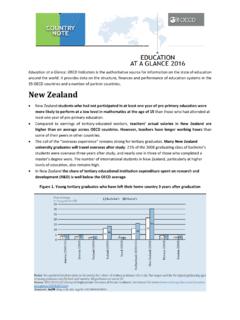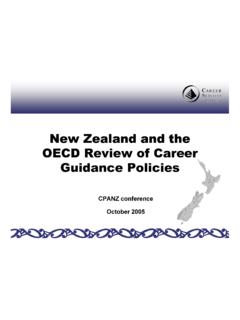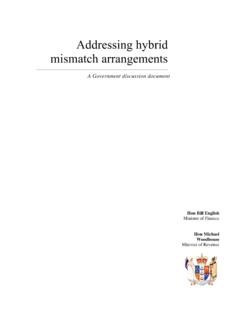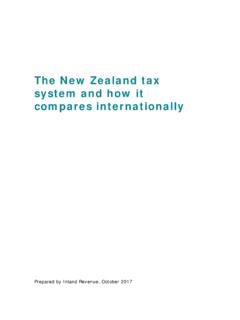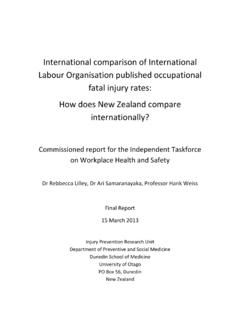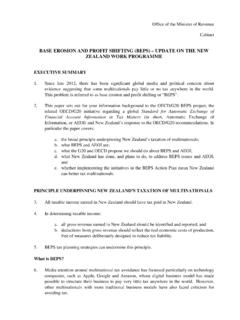Transcription of NEW ZEALAND - OECD.org - OECD
1 3. DEVELOPMENTS IN INDIVIDUAL OECD AND SELECTED NON-MEMBER ECONOMIESOECD ECONOMIC OUTLOOK, VOLUME 2018 ISSUE1 PRELIMINARY VERSION OECD 2018197 NEW ZEALANDS olid economic growth is projected to continue at 3% in 2018 and 2019. Privateconsumption will slow with lower net immigration and moderation of wealth gains fromhouse price increases. Residential investment will be supported by demand in Aucklandand government funding through the KiwiBuild programme. Government infrastructurespending will also rise, while business investment should recover from weakness in late2017 as capacity remains increases in interest rates and government spending will improve themacroeconomic policy balance.
2 Both should also serve to reduce housing marketpressures, but resolution of infrastructure and planning constraints in Auckland iscritical to easing affordability challenges, boosting weak productivity and avoiding afurther house price growth is tightening capacity constraintsEconomic growth was solid in 2017, underpinned by consumption and internationaltourism. Private consumption has been supported by population growth, income gainsfrom record terms of trade, wealth effects from house price increases, a strong labourmarket and accommodative monetary policy.
3 Net immigration, which has been the majordriver of population growth, has begun to moderate, with a small fall in arrivals (in partreflecting tighter eligibility for work visas) and an increase in departures as temporaryimmigrants return home. House price appreciation has also slowed due to higher mortgagerates, tightening lending standards and affordability pressures. Exports were temporarilyweak in late 2017 and early 2018 following a dry period that affected agricultural andrelated investment intentions have recovered somewhat following resolution ofuncertainty around the general election result.
4 Survey measures of capacity utilisation arehigh. The unemployment rate is at a nine-year low, and participation has increased, butNew Zealand1. Moving four-quarter :ANZ Bank; Statistics New ZEALAND ; and OECD Economic Outlook 103 2 2010Q1 = 100 Terms of tradeAggregate commodity priceThe terms of trade is at a record high012345670102030405060702010201220142 0162018Y o y % changes Thousands Real private consumption Net migration Immigration has supported consumption3.
5 DEVELOPMENTS IN INDIVIDUAL OECD AND SELECTED NON-MEMBER ECONOMIESOECD ECONOMIC OUTLOOK, VOLUME 2018 ISSUE1 PRELIMINARY VERSION OECD 2018198labour market tightness has not translated into strong wage growth. In part this is due tomigratory flows of workers into sectors facing labour shortages. The almost 5% increase inthe hourly minimum wage from 1 April 2018 will support income growth but directlyaffects only around 3% of the labour and monetary policy settings are supporting growthFiscal policy is projected to shift to an expansionary stance.
6 Spending increases resultfrom the provision of free tuition for the first year of tertiary education, a substantialpick-up in infrastructure and health spending and increased transfer payments to studentsand families. Additional spending does not threaten fiscal sustainability, with governmentdebt still declining as a share of GDP. The Kiwibuild programme will provide aroundNZD billion per year ( of GDP) for constructing affordable homes, which is expectedto boost housing investment from mid-2019. A proposed ban on foreign housing purchasescould constrain housing investment by increasing compliance costs and uncertainty forforeign developers who would be required to divest after completion.
7 High barriers toforeign direct investment already contribute to low labour of some monetary policy stimulus is projected in 2019 in order to slowinflation, which will be underpinned by capacity constraints and increasing import pricesfrom New ZEALAND s main trading partners. These interest rate increases are expected tostabilise inflation close to the 2% midpoint of the Reserve Bank s target ZEALAND :Demand, output and prices1 2 pricesNZD billionGDP at market prices Private consumption Government consumption Gross fixed capital formation Final domestic demand Stockbuilding1 Total domestic demand Exports of goods and services Imports of goods and services Net exports1 Memorandum itemsGDP deflator
8 Consumer price index Core inflation index2 Unemployment rate (% of labour force) Household saving ratio, net (% of disposable income) General government financial balance (% of GDP) General government gross debt (% of GDP) Current account balance (% of GDP) 1. Contributions to changes in real GDP, actual amount in the first column. 2. Consumer price index excluding food and energy.
9 Source: OECD Economic Outlook 103 database. Percentage changes, volume(2009/2010 prices)3. DEVELOPMENTS IN INDIVIDUAL OECD AND SELECTED NON-MEMBER ECONOMIESOECD ECONOMIC OUTLOOK, VOLUME 2018 ISSUE1 PRELIMINARY VERSION OECD 2018199 Growth is projected to remain solidGrowth is set to continue above the OECD average, at close to potential rates, asactivity shifts away from consumption toward investment. However, if net immigrationdoes not fall to the extent assumed consumption gains will be larger. A sharp housingcorrection is the biggest downside risk, as household debt has risen to high levels relativeto income, and most mortgagees have interest rates that are floating or will be repricedwithin two years.
10 Conversely, short-term growth could be higher if housing shortages inAuckland trigger further price rises and associated wealth effects.












